As every church leader knows, what’s happening in your church is to some extent a reflection of what’s going on in the culture. And when it comes to church attendance statistics and patterns, culture is changing rapidly.
Heading into 2024, there are 5 attendance trends that are worth every church leader’s attention, especially those hoping to see their church reach more people and grow.
First, the bad news. Then, some really promising trends that not only keep hope alive, but have some churches seeing momentum.
Factors Contributing to the Decline in Church Attendance
There’s no surprise here, but as we’ll see below, the overall trends in church attendance are not encouraging: people are leaving the church.
Church membership has been in decline for decades, and along with it has been a similar downward trend in church attendance.
The reason, of course, is that America is increasingly becoming a post-Christian culture. Since the 1990s, according to Pew Research, the number of Americans who have identified themselves as atheists, agnostics, or no reli (the Nones) has risen from 8% to 29% of the population.
Even more shockingly, as recently as the 1990s, 90% of Americans identified as Christians. In 2023, that number fell to just 63% as the religiously unaffiliated surged.
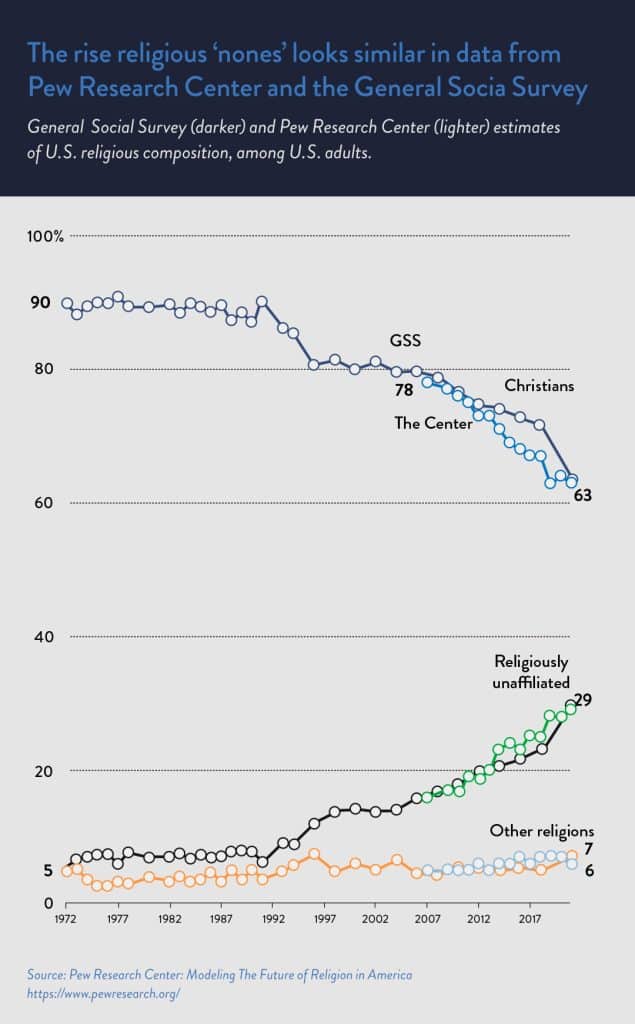
And, of course, the younger you are, the less likely you are to consider yourself Christian and the more likely you are to identify as religiously unaffiliated.
The impact of this cultural trend on church attendance has been a direct hit.
Statistic 1: The Average Senior Pastor Is 60
The average age of senior pastors will be 60 in 2024. And while the clergy continue to creep up to and beyond retirement age, 36% of church members are now over the age of 65.
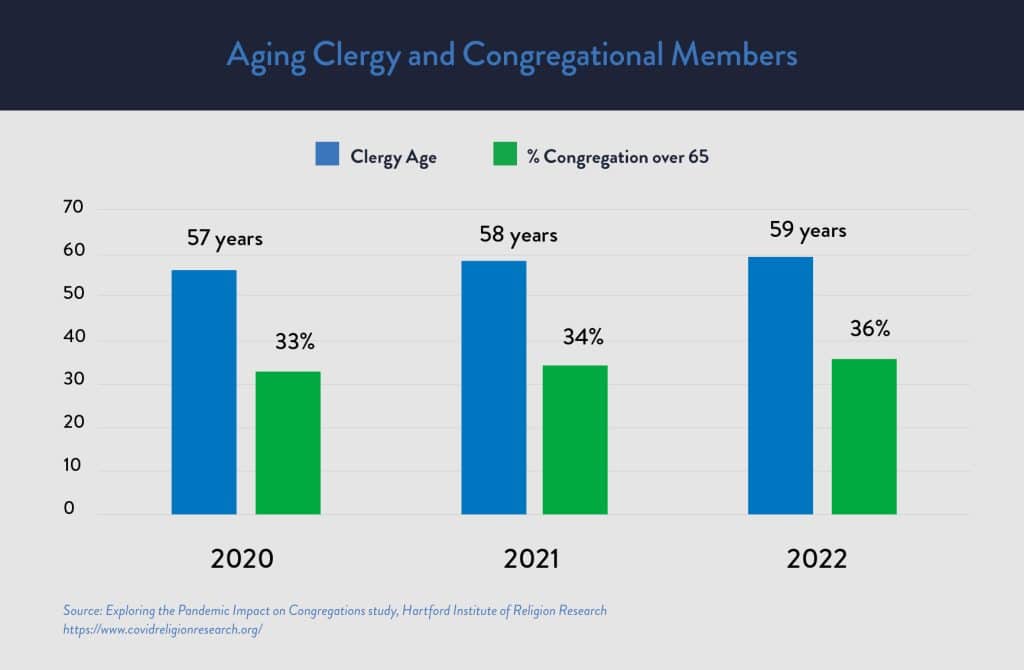
You might ask, well, isn’t the entire population aging out? That’s a good point. After all, the average age of CEOs has crept up to 58. Conversely, the age of the average small business owner is closer to 45.
The challenges associated with aging senior leadership and aging congregations run deep. First, congregations tend to age out with their leaders. One of the best ways you help a congregation grow younger is to have a younger senior pastor.
Second, the aging out of clergy sets us up for a staggering pastoral succession crisis that will only intensify over the next decade.
Not only are younger leaders not entering the ministry at the rate they used to, many haven’t been handed the opportunities previous generations were. They’ve been held back in secondary roles while aging clergy hang onto senior leadership.
Statistic 2: Boomers Are Dropping Out, and Millennials Are Stepping up on All Fronts
The church growth movement of the last four decades has been largely a Boomer-fueled movement. Boomers kept attending, kept serving, and kept giving.
One of the biggest surprises post-COVID is that Boomers didn’t come back to church the way most people expected them to.
According to Barna, 31% of Boomers attended church regularly prior to 2020, but only 22% kept attending post-pandemic.
Some of this is natural as Boomers get older and factors like mobility and health become bigger issues. Some of it might be that Boomers increasingly feel like they’ve ‘done their time’ (a comment I hear regularly from church leaders).
The surprise? Millennial attendance is surging, especially among non-white Millennials.
According to the same Barna survey, 30% of white Millennials report attending church regularly post-COVID, up from 26% pre-pandemic. But non-white Millennials have returned with even greater zeal. Fully 40% of non-White Millennials report attending church post-COVID, up from 31% pre-pandemic.
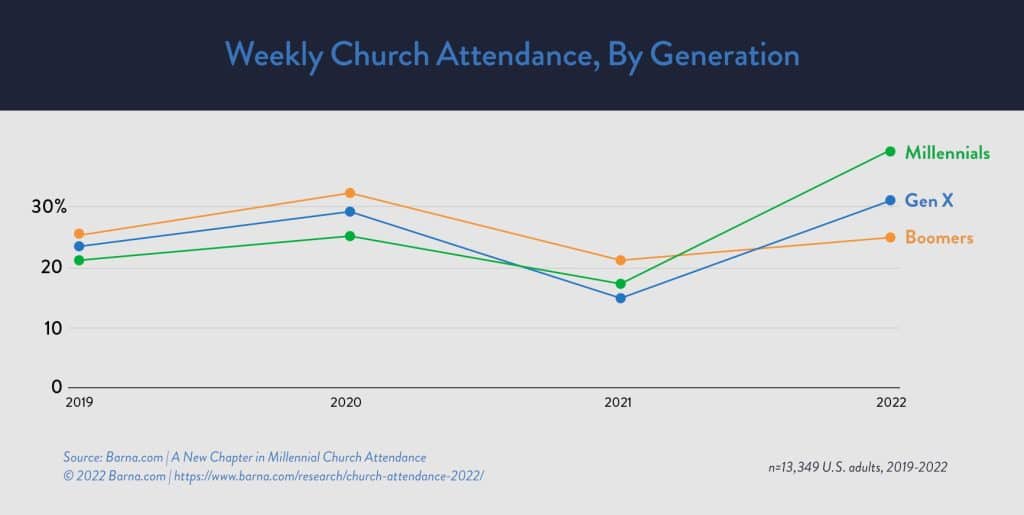
Gallup also reports that Millennials now form the largest demographic of weekly and monthly church attendees, outpacing Gen Z, Gen X, and Boomer attendees.
Notably, Millennials now form the heart of most churches not just in terms of attendance, but in terms of serving and even giving. This is encouraging for many church leaders and long term, can help combat the aging of congregations and their leadership.
Statistic 3: 27% of Church Goers Now Rely on Church Online
Online church services have been around for almost two decades now, but the pandemic moved virtually every church into streaming their services.
While many pastors expected a significant and quick snap back to in-person attendance after the pandemic, the return to church was much slower than most hoped for. While some pastors initially switched off their online services to try to drive in-person attendance, many have realized that’s a short-sighted strategy.
Meanwhile, church online has proven to be quite robust. According to Pew Research, 27% of church attendees now rely on church online on a regular basis – 10% watch solely online, while a further 16% switch between in-person and streamed services.
For Black Protestants, online options are even more popular. 20% of Black Christians only do church online, while 37% toggle between in-person and online experiences.
Additionally, 30% of Christians use the internet to search for information about their faith, and 21% use apps or websites that help them interact with Scripture.
In other words, the internet is here to stay.
The good news for church leaders is that this provides a real growth opportunity. After all, everyone you want to reach is online.
Statistic 4: The “Stable” Church Is Disappearing. One-Third of Churches Report That They’re Growing, While 54% Are Declining
While many church leaders are perpetual optimists, and self-reported data can be misleading, 33% of church leaders report that their congregation is experiencing “some growth” or “significant growth.”
While I don’t have precise data to show for my next observative, in talking to hundreds of church leaders, what I’m seeing is that some churches are really struggling a few years after COVID, while others are growing quickly. In other words, the growth is not only not evenly distributed, it’s accelerating the expansion of a relatively small number of churches.
The findings of this study seem to suggest a similar trend. 54% of churches are reporting some or ‘much’ decline.
In other words, churches that have momentum are gaining even more momentum, while churches that don’t have momentum are losing people just as quickly.
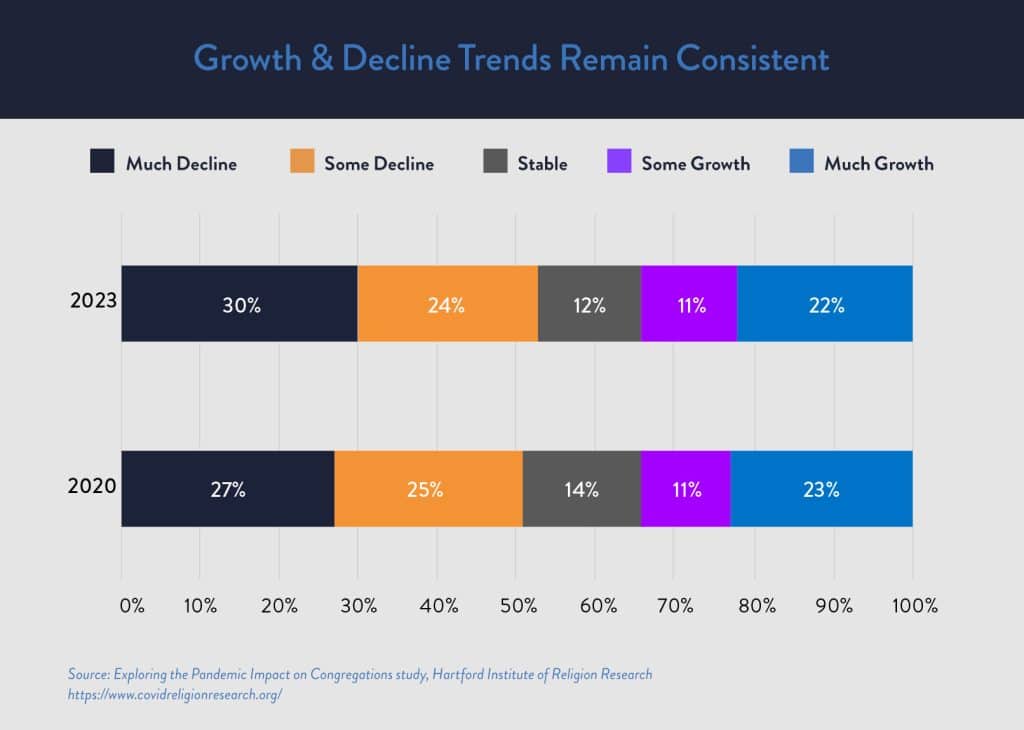
So what does this mean?
My take is that the church is going through a period of consolidation. Not all the growth among rapidly growing churches is conversion growth. Much of it is Christians finding a church that suits them better.
The pandemic shook things up significantly. People broke longstanding patterns of where they attended church. Many moved. Still others changed jobs. And when people plugged back in in 2022 and beyond, they plugged back in differently, often finding churches that had momentum rather than going back to their old church, which might not have had the same offerings.
The caveat is that even if your church is experiencing significant growth, it’s important not to neglect the task of reaching unchurched people. Attracting other Christians doesn’t fulfill your mission. Reaching people for Christ fulfills your mission.
Meantime, 54% of churches report that they’re experiencing some decline to ‘much’ decline. Only 12% report being stable.
The bottom line? You’re either growing or declining. Stable isn’t happening much anymore in a rapidly changing culture.
Statistic 5: Online Church Is Boosting Church Attendance, but It’s Still Half of What It Was in 2000
As we’ve already seen, church online is here to stay, even among small churches.
In 2020, the median congregational size was 65 in worship. In 2023, in-person attendance dropped by an average of five more people, to just 60 in worship. But, when you add people watching online, overall median attendance jumped to 75.
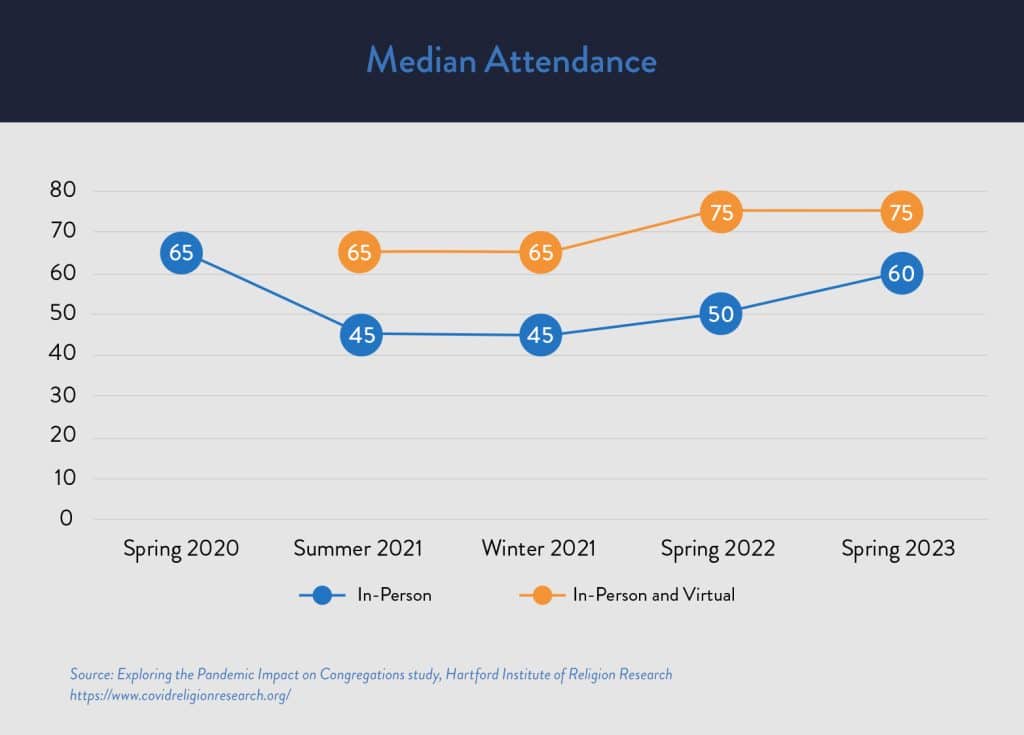
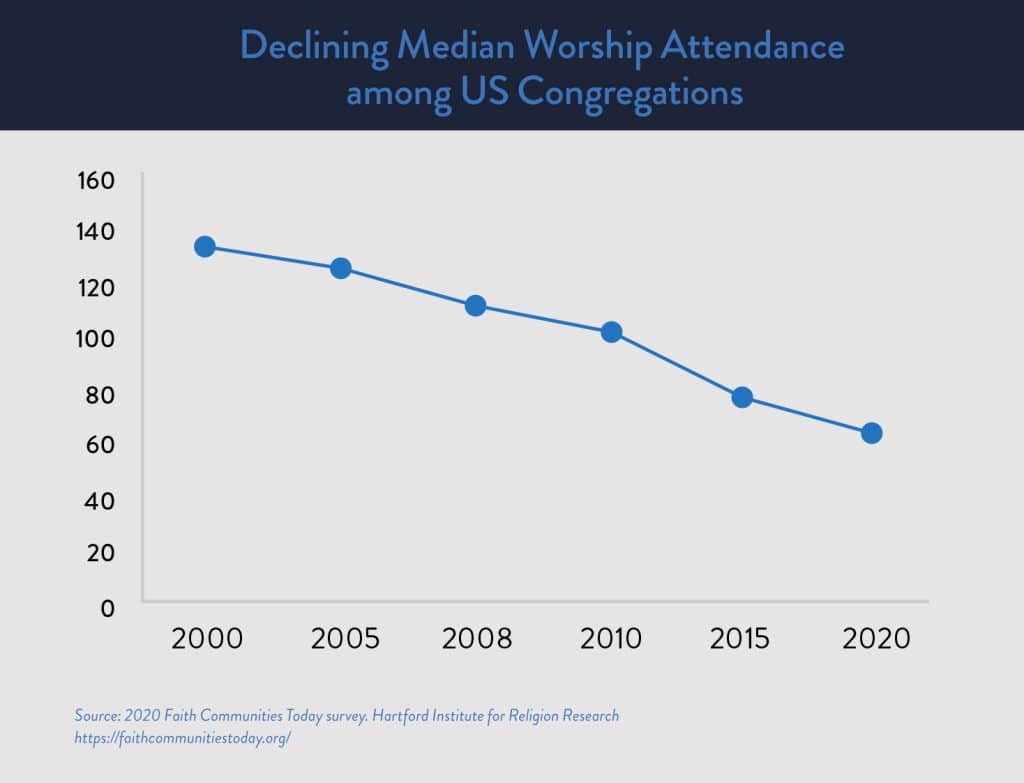
While that’s still half of what it was in 2000, just two and a half decades ago, when 135 people attended Sunday services, that’s an encouraging trend. Especially given the fact that very small churches often have no digital presence.
While data is still scarce, anecdotally, I’ve heard of more than a few churches that are breaking in-person attendance records and continuing to see their online number grow, even well beyond pandemic levels when everyone ‘had’ to watch online.
My guess is this will become normative for growing churches – a full or nearly full room on Sunday and a robust online presence in addition to that.
The answer to whether your church should have an in-person or online ministry in the future is simply “yes.”
So What Does All of This Mean?
Well, a few things.
As America becomes more and more post-Christian, a growing number of churches resistant to change or trying to minister to a culture that no longer exists will struggle and disappear. Add to that an aging clergy, aging congregations, and a lack of young leaders, and the future will have fewer churches than we’ve ever known.
However, the churches that remain will gain momentum. The 33% of churches reporting some growth or much growth will be the churches of the future.
These churches will tend to be larger, younger, and better-resourced than the churches that are declining and fading away. Naturally, some will be church plants that are tight on resources, but most of today’s vibrant and growing churches were church plants 5, 10, and 20 years ago.
With the stable church disappearing, church revitalization will become more important than ever, spurring marginal congregations on to new growth and a new future.
The culture needs the church more than it ever has before. The seeds for the renewal of the church have already been planted, and some are ready to grow.







